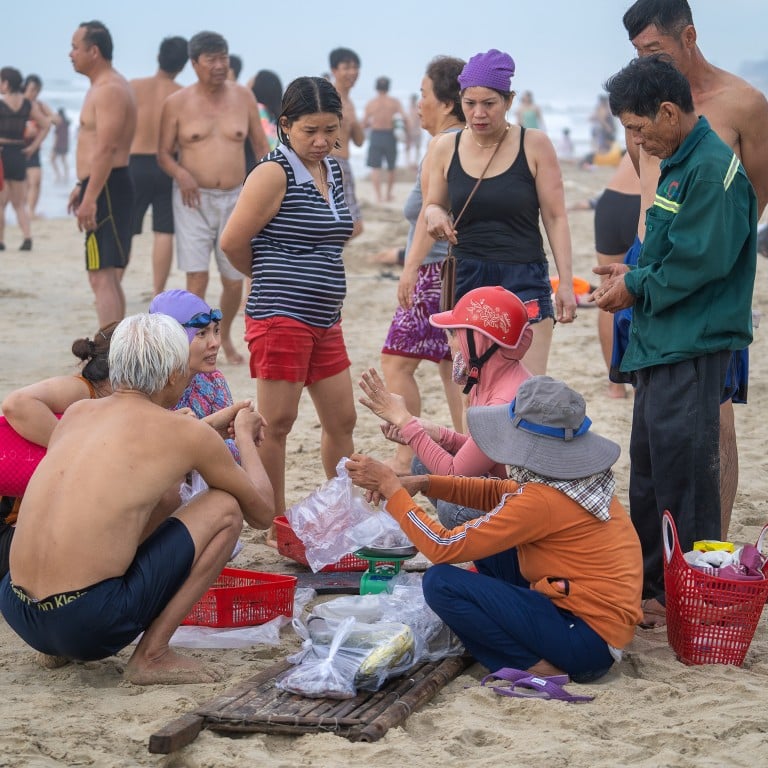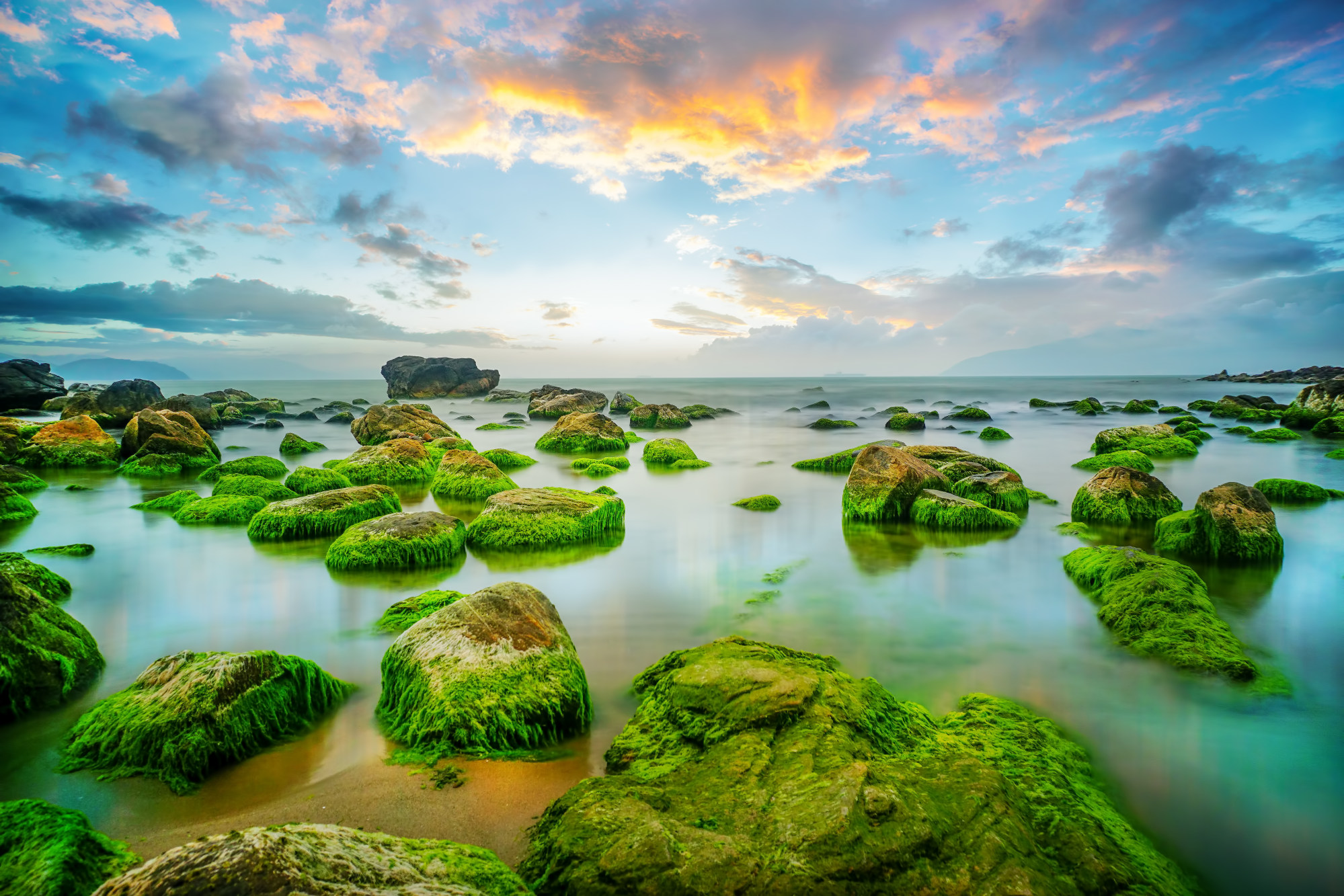
Vietnam’s Nam O Beach in Da Nang hits headlines with its litter-strewn sands, highlighting a far bigger problem in the city
- Nam O Beach went viral this month as an annual phenomenon drew crowds, but it was the rubbish they left behind that provided the bigger talking point
- Da Nang’s rubbish troubles don’t end at the beach, however, with the city described as a ‘giant refuse site’ and that it is ‘no wonder tourists rarely return’
The colour green has become symbolic of environmental integrity and, on traffic lights and elsewhere, an indication that you should proceed.
But in Da Nang, Vietnam, it has signalled a procession to the seaside for a spot of environmental trashing.
The city’s Nam O Beach went viral and made headlines this month as an annual phenomenon drew the crowds and their camera phones, reports the Tuoi Tre newspaper.
Spring’s warming weather aids the growth of green sea moss on the beach’s grey rocks. The effect, with ocean waves crashing in the background, creates a “stunning backdrop for photos”, explains the newspaper.
“Soon, the location became known as a ‘check-in point,’ with thousands of local residents and tourists flocking to the place.”

The early birds caught the Insta-worm but those who came later had to first pick their way through the litter dumped by the first arrivals.
“I liked it so much after seeing photos on social media that I told my son to drive me here, but I didn’t expect such dirtiness and a mess,” the newspaper quotes Nguyen Thi Hong Sen, who travelled nearly 60km (35 miles) from Hue, as saying.
Although the moss, or algae, returns each spring, Nguyen Huu Canh, who lives close by, said there had “never been a year when so many visitors have thronged the place to take pictures like in the past few days”.
He blamed much of the mess on locals who had taken advantage of the unusual influx to set up stalls selling snacks and beverages and mark out unapproved car parks for the descending hordes.
Da Nang probably isn’t that unusual in Vietnam when it comes to being rubbish strewn, but its problems don’t end at Nam O Beach.
A November 2022 VnExpress article highlights the extent to which the Hoang Sa – Vo Nguyen Giap – Truong Sa coastal road, which connects the Son Tra Peninsula to tourist hot spot Hoi An, is used as a dumping ground.
A series of photos, taken at various locations, shows rubbish discarded from an impromptu daily market; uncleared debris from where the pavement was dug up by a utility company; furniture stored on the pathway and beach by restaurants closed for the winter; nets, boats and repair equipment belonging to fishermen pulled up and deposited on the far side of the coastal road; derelict bus shelters; abandoned construction sites and their associated rubble; and general rubbish.
All forced pedestrians to make detours or walk in the road.

“Hoang Son Tra, chairman of the Son Tra District People’s Committee, said people throwing debris without permission are normally fined,” reports the VnExpress, “but not all cases are detected in time since the area that requires monitoring is too large.”
And that’s no understatement.
“The whole city of Da Nang looks like a giant refuse site,” writes a reader in the comments section below the coastal road article. “None of the citizens or visitors have any idea of what environmental care means. You finish with something, you throw it on the floor.
“The local government are the same, operating a waste disposal area on the footpath on D. Mai Thuc Lan street. It looks and smells disgusting. It is an environmental disaster and a serious health concern.
“No wonder tourists rarely return to Da Nang.”
Quite.
Bali social enterprise offers ‘regenerative’ experiences

Go to Bali, hire a scooter; it’s how one gets around.
Although there is another way; the Astungkara Way.
“We create alternatives to mass tourism that benefit local economies, culture and ecosystems,” says the website of the social enterprise, which was launched in 2020 but, because of the pandemic, is only now getting the publicity it deserves.
“We do this by offering regenerative experiences, working with farmers to market regenerative products and helping organisations join this movement.”
Those regenerative experiences include two-, five- and 10-day trail-walking tours led by local guides, and farming experiences during which visitors get their hands dirty either on a farm or at one of the project’s two learning centres.
Dirty hands trump the grazed legs of scooter accidents, we reckon, so astungkara (which means “hopefully” or “god willing” in Balinese) we’ll get to experience this new venture some day soon.
Learn to build traditional walls on a British cottage holiday

Getting your hands dirty and giving a helping hand to the modest farmers of Bali is one thing, but what about spending your holiday building walls for the landed gentry of Britain – and forking out £145 (US$175) for the privilege?
Cotswolds Hideaways, a purveyor of holiday cottages in the picturesque English west, is selling courses on how to build traditional walls that take place on some of the area’s private estates.
The website says, “You’ll spend a full weekend in the glorious Gloucestershire countryside learning to build a dry stone wall […] and leave having been guided through all the basics of traditional Cotswold dry stone walling.”
Unfortunately, you don’t get to keep the wall.
Thailand to start imposing tourist levies in June
Trips to Thailand will be slightly dearer come June, when the government begins imposing levies on foreign holidaymakers.
Travellers flying into Thailand will need to pay 300 baht (US$8.70) for each trip, while those entering by land or sea will have to cough up 150 baht.
“The government expects to collect about 3.9 billion baht [US$113 million] in fees this year and a part of it will be used to provide health and accident insurance cover for the tourists during their stay in the country,” the Bloomberg news wire quotes Tourism Minister Phiphat Ratchakitprakarn as having said.
The levy has long been mooted but its implementation was delayed by the pandemic. Air passengers will hardly notice as the levy will be added to ticket prices, but the method of collection at land borders has yet to be determined.

